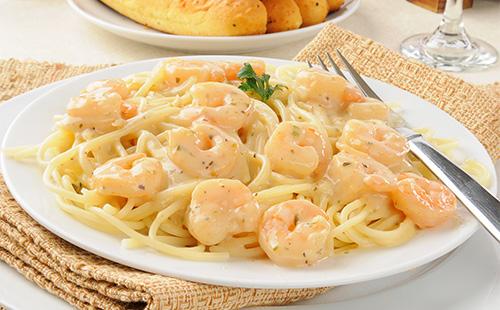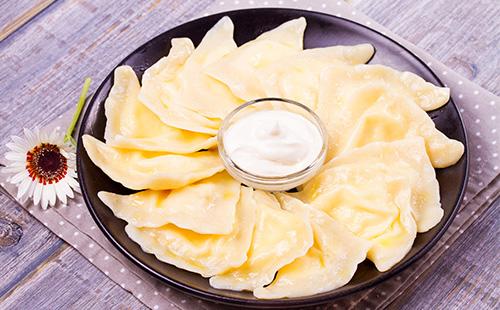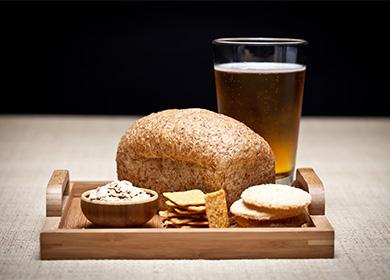The content of the article
Gluten refers to high molecular weight protein compounds whose chain structure is distinguished by multiple branches and contains a huge number of chemical compounds. Its main source is wheat endospermia. It was from wheat flour that Cesare Beccaria isolated a pure compound, which in our time is very widely used by the food industry.
Connection role
Gluten and gluten are considered identical concepts. The name of the substance comes from the word "gluten" - to glue. From here one can accurately judge the basic physical characteristics of the protein compound. In dry form, it is a translucent powder without taste and aroma. When wetted with water, it swells and turns into a viscous grayish substance without color and odor, but able to glue various surfaces.
The food industry especially appreciates the uniformity of the structure of moistened gluten, because this substance allows you to achieve an interesting creamy consistency of food products. Humanity uses gluten as:
- natural food preservative;
- natural thickener;
- a substance that improves the quality of bakery products;
- household glue.
Interestingly, gluten is a particularly important component for bakeries. It is he who gives the test viscosity, sticks together the pores, preventing carbon dioxide from leaving the baking sheet. Thanks to gluten, the bun is not just rich, but soft and porous. It is the increased amount of this protein that makes bread top-notch. Breeders are fighting for wheat varieties, the quantitative content of gluten in which exceeds 30%.
Myths and real danger
Once in the human body, gluten turns into a viscous substance that is not always absorbed by the body. Many believe that it envelops the intestines, preventing the beneficial substances from being absorbed through its walls. Here is a refutation of some misconceptions regarding the harm of vegetable protein.
- Does not stick together. This substance is not able to glue the stomach, intestines or anything else inside the human gastrointestinal tract.
- Not caloric. Gluten can not be called a caloric compound. Most of its decay products are amino acids that are actively used by the body for construction purposes.
- It does not cause allergies. The compound is an allergen only for those people who are genetically predisposed to it (patients with celiac disease), for all others, this substance is harmless.
What does gluten do all the same? Excessive consumption of gluten-containing foods causes digestion, namely, fermentation, rotting. This is especially true for people suffering from microflora disorders or chronic intestinal diseases. Prolonged excessive consumption of foods with a high content of gluten leads to the expansion of gaps between the filtering fibers of the intestine.This contributes to the absorption of not only vitamins, water and other goodies, but also toxins, allergens, decomposition products, which ends with general intoxication of the body or the occurrence of chronic diseases:
- oncological;
- articular;
- of cardio-vascular system;
- CNS.
The real fear of gluten induces patients with a diagnosis of celiac disease - a genetically determined intolerance to the substance. Particles of substance settled on intestinal villi in them cause an autoimmune attack of intestinal tissues, which is fraught with big problems and can end fatally. Such people are simply forced to adhere to a gluten free diet all their lives. Only in this case they can live long and high quality.
Scientists also identify a population group with increased sensitivity to gluten. Often, one of the parents has celiac disease or has enzymatic deficiency. Gluten use by sensitive people leads to intestinal malabsorption, manifested by:
- bloating, flatulence;
- intestinal cramps;
- vitamin deficiency;
- chronic fatigue syndrome.

Gluten free diet
The diet, which implies a complete rejection of gluten-containing products, just blew up the world of show business, fashionistas, writers. Gwyneth Paltrow and Lady Gaga have been practicing it for several years, showing off their figures, as well as excellent health. Adherent to the diet, cardiologist William Davis has published a treatise on the benefits of gluten-free restrictions.
But scientists are clearly criticizing the gluten-free diet, attributing it to a tribute to fashion, as well as the tricks of food magnates, because gluten free products are more expensive than usual. Mankind has always managed to find a special food enemy. So, what is a gluten-free diet good for?
- Limits high-calorie foods. Indeed, almost all the development of the food industry containing gluten is characterized by a high calorie content.
- Increases the amount of vegetables in the diet. And they are a source of fiber, acids, vitamins, which provides not only bowel cleansing, but also the saturation of the body with various useful substances.
- Improves all systems and organs. Indeed, due to the naturalness and purity of the products used (as well as gentle processing), their beneficial qualities are maximally preserved.
Some nutritionists agree with scientists. They criticize the gluten-free diet, arguing that wheat and even bakery products provide the body with vitamins, minerals, and protein compounds. The main source of health problems and obesity is not gluten itself, but the amount of food eaten with its content. It is also important that, in addition to it, it is contained in the same product. If this is only gluten, then its damage to health is very doubtful, and if additives, dyes, etc., then this "goodies" is not allowed for anyone.
Scientists also say that many manufacturers of food delights compensate for the exclusion of gluten by other additives: fats, sugar and sweeteners, flavorings. Therefore, most gluten-free products cannot be called low-calorie, and the benefits of their use are only to guarantee that there is no allergy to gluten.
In general, the complete exclusion of gluten is recommended only to people with its intolerance. And for the purpose of losing weight, you need to focus on the following rules of nutrition:
- observe moderation in relation to the portion sizes;
- enrich the diet with natural products;
- choose products with minimal industrial processing;
- reduce the quantity but improve the quality of the side dishes;
- provide a balanced, varied, low-calorie diet.
Gluten-Free Products List
It always begins with cereals: wheat, barley, rye. This is the basis of pasta and bakery products. It is important to know that gluten is also found in oats, millet and any cereal made from these crops. The same applies to drinks made from cereals:
- whiskey;
- vodka;
- beer;
- kvass.
To obtain a uniform consistency, improve taste characteristics, as well as as a preservative, it is added to other food products:
- confectionery - sweets, milk chocolate, cocoa powder, marshmallows, creams, ice cream;
- milk products - yogurt, fermented baked milk, kefir, milkshakes, cottage cheese;
- sauces - ketchup, mayonnaise, soy sauce;
- sausages- sausages, cooked smoked sausages;
- semi-finished products - dumplings, crab sticks, meatballs, snacks.
Modern food manufacturers do not like to call gluten by his name, and therefore indicate him as “modified starch”, “vegetable protein”, “modified corn starch”.

"Free" food
People with celiac disease should look for foods completely free of gluten. And even better - with a note that they can be used for intolerance. As a rule, they are placed on separate shelves of the supermarket, and also marked with marks:
- crossed out spikelet;
- gluten free.
With gluten intolerance, you can use the following products (with the condition of separate preparation):
- rice
- buckwheat;
- corn;
- quinoa;
- soy;
- legumes;
- whole milk;
- dairy products made from milk on their own;
- meat;
- eggs
- fish
- fruits;
- vegetables;
- honey.
An allergy in a patient with celiac disease can even provoke the use of one equipment for the preparation of gluten-free and gluten-containing dishes. For example, if you stir the vegetable soup with the same spoon with which the pasta is mixed.

